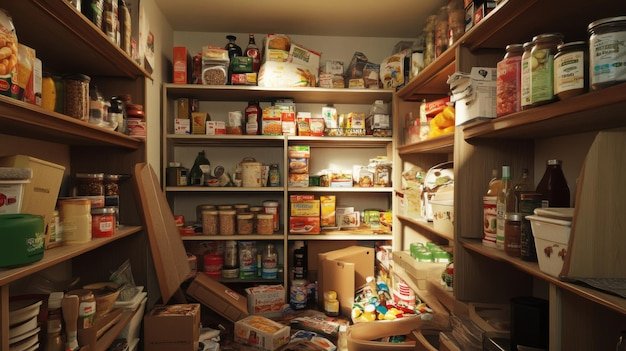Shopping hauls can be a strategic way to purchase multiple items at once, save money through bulk buying, and organize your spending habits for a more efficient lifestyle.
Are you ready to transform your shopping habits into a money-saving adventure? **Shopping hauls** can be a powerful tool for smart consumers looking to maximize their budget and stock up on essentials. Let’s dive into how to master the art of shopping hauls and make every purchase count.
What Exactly Is a Shopping Haul?
A shopping haul is more than just a simple shopping trip. It’s a planned excursion where you purchase multiple items with a specific purpose, often involving bulk buying or stocking up. Understanding the core concept of a shopping haul can help you approach your shopping trips with more intention and strategy.
Defining a Shopping Haul
A shopping haul typically involves purchasing a large quantity of items in one go, often focusing on essentials or frequently used products. Unlike impulse shopping, a shopping haul is usually pre-planned and based on needs and budget considerations.
Benefits of Strategic Shopping Hauls
There are several advantages to adopting a strategic shopping haul approach. These include saving money through bulk discounts, reducing the frequency of shopping trips, and maintaining a well-stocked supply of essential items.
- Cost Savings: Buying in bulk usually comes with lower per-item costs.
- Time Efficiency: Fewer trips mean less time spent in stores.
- Better Budgeting: Planning ahead helps avoid impulse buys and keeps spending in check.
- Stress Reduction: Knowing you have enough supplies on hand can reduce anxiety.
By understanding what a shopping haul entails and the potential benefits, you can start planning your shopping trips more effectively, saving both time and money while ensuring you always have what you need.

How to Plan Your First Shopping Haul
Planning is the cornerstone of a successful and efficient shopping haul. A well-thought-out plan ensures you buy what you need without overspending or accumulating unnecessary items. Let’s explore the essential steps to planning your first shopping haul.
Assessing Your Needs
Start by evaluating what you and your household truly need. Go through your pantry, fridge, and other storage areas to identify items that are running low or need replacing. Make a comprehensive list to guide your shopping.
Setting a Realistic Budget
Determine how much you can realistically spend on your shopping haul. Consider your monthly income, existing expenses, and savings goals. Sticking to your budget is crucial to preventing overspending and maintaining financial stability.
Creating a Detailed Shopping List
Based on your needs assessment and budget, create a detailed shopping list. Organize the list by category, such as groceries, household supplies, and personal care items. Include specific brands and quantities to avoid confusion in the store.
When planning your shopping haul, consider seasonal sales, coupons, and loyalty programs that can help you save even more. A bit of foresight can significantly enhance the benefits of your shopping strategy, ensuring you get the most value for your money.
Where to Find the Best Deals
Finding the best deals is a crucial part of mastering shopping hauls. Knowing where to shop and how to leverage discounts can maximize your savings. Let’s explore the top places to find great deals and how to make the most of them.
Exploring Local Grocery Stores
Local grocery stores often have weekly sales and promotions on essential items. Check their flyers online or in-store to see what’s on sale and plan your haul accordingly. Many stores also offer loyalty programs that provide additional discounts and rewards.
Warehouse Clubs
Warehouse clubs like Costco, Sam’s Club, and BJ’s Wholesale Club are excellent for bulk buying. They offer significant discounts on a wide range of products, from groceries and household supplies to electronics and clothing. Membership fees can be worth it if you frequently buy in large quantities.
Online Retailers
Online retailers such as Amazon, Walmart, and Target offer competitive prices and often have flash sales and promotions. Subscribe to their newsletters to stay informed about upcoming deals. Consider signing up for their subscription services for additional savings on everyday items.
- Compare Prices: Use price comparison tools to ensure you’re getting the best deal.
- Use Coupons: Look for online coupons and promo codes to reduce your total cost.
- Check for Clearance Items: Many retailers have clearance sections with heavily discounted products.
- Take Advantage of Subscription Services: Services like Amazon Subscribe & Save offer discounts on recurring purchases.
By exploring various shopping venues and employing smart strategies like price comparison and coupon usage, you can optimize your shopping hauls and save substantial amounts of money over time.
Tips for Organizing Your Shopping Haul
Once you’ve completed your shopping haul, organization is key to maximizing the benefits and preventing waste. Proper organization ensures that items are stored correctly, remain accessible, and are used efficiently. Here are some tips for effectively organizing your shopping haul.
Storing Food Items
Proper food storage is essential to maintain freshness and prevent spoilage. Store perishable items like meat, dairy, and produce in the refrigerator or freezer according to their specific requirements. Use airtight containers to keep food fresh and prevent contamination.
Arranging Household Supplies
Organize household supplies in a designated area, such as a pantry or storage room. Group similar items together and label shelves for easy identification. Store heavier items on lower shelves to prevent accidents and make them easier to access.
Managing Personal Care Products
Personal care products should be stored in a cool, dry place away from direct sunlight. Organize them by category, such as skincare, hair care, and hygiene products. Use storage containers or drawer organizers to keep items neatly arranged and easily accessible.
Efficient organization not only helps you keep track of what you have but also reduces the likelihood of buying duplicates, minimizing waste and saving money in the long run. A well-organized shopping haul contributes to a more streamlined and cost-effective lifestyle.
Common Mistakes to Avoid During a Shopping Haul
Even with careful planning, it’s easy to make mistakes during a shopping haul that can undermine your savings and efficiency. Being aware of these common pitfalls can help you avoid them and ensure a successful shopping experience. Let’s explore some frequent errors to watch out for.
Impulse Buying
Resist the temptation to buy items that are not on your shopping list. Impulse purchases can quickly derail your budget and lead to unnecessary accumulation of products. Stick to your list and avoid browsing aisles with tempting, non-essential items.
Overstocking
Buying too much of a product can lead to waste if you can’t use it before it expires or goes bad. Assess your consumption habits and purchase quantities that align with your actual needs, ensuring you can use the items within a reasonable timeframe.
Ignoring Expiration Dates
Always check expiration dates before purchasing food and personal care items. Buying products that are close to their expiration date can result in waste and lost money. Opt for items with longer shelf lives to maximize their usability.

By avoiding these common pitfalls, you can maintain control over your spending, reduce waste, and ensure that your shopping hauls are both cost-effective and beneficial.
Future of Shopping Hauls
The future of shopping hauls is evolving with technological advancements and changing consumer behaviors. Understanding these trends can help you adapt your shopping strategies for continued success. Let’s dive into the innovative changes on the horizon.
Technological Innovations
Advancements in technology are transforming the way we approach shopping hauls. Mobile apps, AI-powered shopping assistants, and personalized recommendations are making it easier to plan and execute efficient shopping trips. Augmented reality (AR) can also help visualize how products will look in your home before you buy them.
Sustainability and Ethical Consumption
Consumers are becoming more conscious of the environmental and social impact of their purchases. Sustainable shopping hauls involve buying eco-friendly products, supporting ethical brands, and reducing waste. Look for items made from recycled materials, packaged in sustainable materials, and sourced from companies with fair labor practices.
Personalized Shopping Experiences
Retailers are increasingly using data analytics to offer personalized shopping experiences. Tailored recommendations, customized deals, and loyalty programs based on individual preferences are becoming more common. Embrace these tools to optimize your shopping hauls and get the best value for your money.
The future of shopping hauls promises to be more efficient, sustainable, and personalized, enhancing the overall shopping experience and helping you achieve your financial and lifestyle goals.
| Key Point | Brief Description |
|---|---|
| 💰 Budgeting | Setting a realistic budget prevents overspending during shopping hauls. |
| 🛒 Planning | Creating a detailed shopping list helps avoid impulse buys. |
| 🛍️ Deals | Finding the best deals maximizes savings through bulk buying. |
| 🗄️ Organization | Proper organization prevents waste and ensures efficient use of items. |
Frequently Asked Questions
▼
▼
▼
▼
▼
Conclusion
Mastering the art of shopping hauls involves careful planning, strategic shopping, and efficient organization. By understanding your needs, setting a budget, finding great deals, and avoiding common mistakes, you can transform your shopping habits into a cost-effective and satisfying experience. Embrace these strategies to take control of your spending and enjoy the benefits of a well-stocked and organized lifestyle.